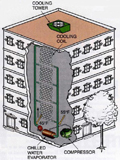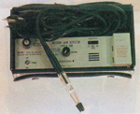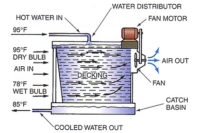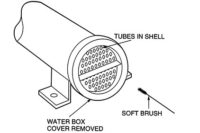
Figure 1. This multi-story building has a chilled water circuit that furnishes chilled water throughout the building. The refrigerated chilled water is furnished by a chiller in the basement. (Figures are from Refrigeration & Air Conditioning Technology, 5th Edition, by William Whitman, William Johnson, and John Tomczyk, published by Delmar Cengage Learning.)
The building manager said, “The building seemed to be cool enough Friday when everyone went home for the weekend. The timer is set to shut the cooling system off Friday at 5:30 p.m. and turn the system back on Monday morning at 7:00 a.m. When I arrived, I noticed that the unit was running, but the building was not cool like it usually is. I went to the basement and the compressor was running, like it is now, but the building temperature was 76°. We usually keep the building at about 73°.”
Bob said, “I will look around and see what I can find out.”
Bob went to the basement and began to look around and noticed that the chilled water pump was running and the condenser water pump was running. The leaving chilled water design temperature was 45°, but the water leaving the chiller was 50°. He then looked at the gauges on the compressor and the suction pressure was 65 psig and the head pressure was 180 psig. The refrigerant was R-22. He was standing there trying to put these figures into perspective when Btu Buddy appeared.
Bob said, “Thank goodness you are here. I am getting confused. The suction pressure is a little low and the head pressure is about right but the unit is not cooling the water down to the 45° design setting.”
Btu Buddy said, “Let’s take it one step at a time to get to the bottom of this. Give the system the touch test. How does the suction line feel? How does the liquid line feel?”
Bob touched the suction line as it entered the compressor and said, “The suction line is not very cool.”
Then he touched the liquid line and said, “The liquid line is a little warm for the head pressure to be this low.”
Btu Buddy then asked, “How about the sight glass? Is it full of liquid?”
Bob looked at the sight glass and said, “No, it is only about half full.”
“What does that tell you, Bob?” asked Btu Buddy.
“Well, all signs point to a low charge. Let me check the compressor amperage,” Bob said.
Btu Buddy then said, “You are on the right track now. See how hard the compressor is working. The full load amperage is 100 amps.”
Bob checked the amperage and it was showing 35 amps. Then he said, “The compressor is only operating at about 35 percent of full load. The system is calling for full load and the compressor is not working at full capacity. I guess the compressor must be defective.”
Btu Buddy said, “It would be easy to make that conclusion, but let’s check a little further before condemning the compressor. This compressor unloads based on suction pressure. If the suction pressure begins to fall, the compressor will unload. What may cause the suction pressure to drop?”

Figure 2. This electronic leak detector can detect refrigerant leaks down to about 1/4 ounce per year.
Btu Buddy then said, “If you add refrigerant, you may have to just take it back out again if the leak cannot be repaired with refrigerant in the system. Let’s see if we can find the leak first. Shut the compressor off and let the pressures equalize while you get your leak detector warmed up.”
Bob turned off the compressor and went to the truck for his electronic leak detector (Figure 2).
When Bob returned, the low side pressure was up to 132 psig because the chilled water was now up to 75°. The head pressure was about the same because the tower water was also about 75°. Bob plugged in his electronic leak detector and tried to get it to settle down, but there was too much refrigerant in the air. He looked at Btu Buddy with a question mark look on his face.

Figure 3. This halide leak detector is not as sensitive as the electronic leak detector and can be used where there is a lot of background refrigerant.
Bob again went to the truck and got the halide leak detector, which was much less sensitive. He lit it outside the room and walked into the room. It showed refrigerant in the air, so he went over to the chiller and began to pass the sensor over the various piping. When he got to the gauge line going to the panel gauge, he discovered a huge leak. The gauge line had been rubbing the side of the compressor and it had rubbed a hole in the gauge line.
Bob said, “Boy are we lucky with this one. It has a valve where we can just shut off this line, an isolation valve.”
Bob shut the valve off and repaired the leak and was ready to start the system back up. He put his gauges on the unit and connected a large cylinder of refrigerant to the gauge center port. He bled all of the air out of the gauge lines and started the chiller. He placed the cylinder on a set of scales so he could accurately weigh in the refrigerant charge.
The manager walked in about that time and said, “I am glad to hear it running. Did you find the problem?”
Bob showed him what had happened and the manager said, “I am glad to hear that it wasn’t something major. The people in the building are beginning to complain.”
Bob said, “Tell them that cooling is on the way.”
Bob added refrigerant and the sight glass filled up with liquid and he noticed that the compressor was now operating at full load and the leaving chilled water was now 45°. He was really feeling good about the job and started to disconnect the refrigerant cylinder when Btu Buddy said, “You have not charged for 10° of subcooling.”
Bob then said, “You are right. Just because the sight glass is full, the system may not have a full charge of refrigerant. I am going to the truck for my temperature tester.”
Bob connected the temperature tester lead to the liquid line and insulated it. He then charged the system until it had 10° of subcooling. The head pressure was 211 psig, corresponding to 105° condensing temperature and he added refrigerant until the liquid line temperature was 95°.
Btu Buddy now said, “The system will get maximum efficiency from this charge of refrigerant. You did it right, Bob. Now, wipe down where the oil leaked out of the gauge line. If you don’t wipe that down, the next technician may think there is still a leak there.”
Bob said, “You are right. We owe the customer the best job we can do.”
Publication date:06/22/2009









